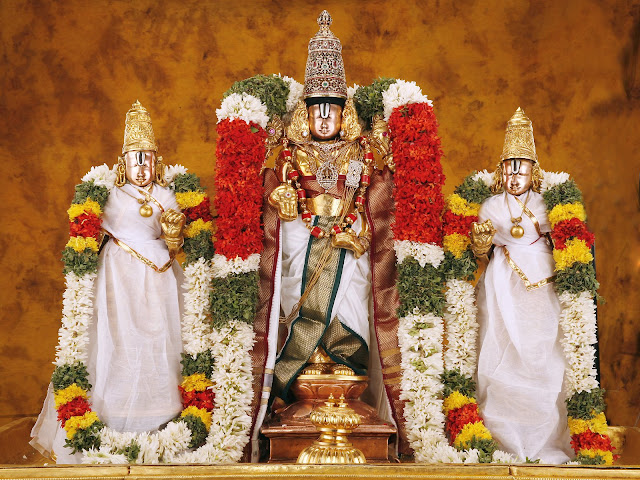Maha Shivaratri - The great night of Shiva - Its Importance
Thursday, 26 February 2009
Sponsored Links
which means...
"In this Universe there is no sacred place equivalent to Venkatadri(i.e.,There is no place in the whole Universe which is more auspicious than the hill Venkatachala). There is no God equivalent to Lord Venkateswara neither in the past nor in the future going to be(i.e.,There is no Archa murti (worshippable form) in all the three times (present,past and future) whose glories are comparable to the Lord of Venkatachala)"
The great night of Shiva – popularly called Maha Sivaratri is becoming one of the most celebrated festivals in the country and in several pockets of the world. It is the time when the energies of the conscious principle of our being are predominant in the atmosphere. On this day mediators sit upright, rather than lie down and go to sleep. In this position they align their thought to contemplate on the auspiciousness that is represented by the form of Shiva.
There are many explanations to the lore of Mahasivaratri – ranging from the utterly devout and religious framework to the more scientific and rational aspect of its celebrations. From a religious point of view, people offer their prayers in temples where special pujas are conduced al through the night, from 6 pm to 6 am. Mahasivaratri was recently celebrated in the country on February 23 in temples, home and as public gatherings with bhajans and satsanghs.Putting it in a very logical context, Sadhguru Jaggi Vasudev, who founded the Isha Yoga Centre, says Mahasivarathri falls in February or March every year. “This night celebrates the Grace of Shiva, who is considered the Adi Guru from whom the Yogic tradition originates. The planetary positions on this night are such that, there is a powerful natural upsurge of energy in the human system. It is enormously beneficial to one’s physical and spiritual well being to stay awake and aware, throughout the night, “he says.
Just as all other deities in the pantheon of Hindu Gods, Shiva also represents an ideal. This ideal of a total connectedness of the individual consciousness to the cosmic consciousness, which is the supreme state of Yoga is represented by Shiva. The image of a deity is but like a map of India or the world map to give students a mental picture of what a deity is and qualities it stands for.
Meditating upon that idol or picture or chanting the name of Shiva as Om Namah Shivaya or Shambho Mahadeva, has the ability to connect the mind to the universe. The Yogic tradition has it that Shiva was the first teacher of Yoga and the first student was Parvathi, his consort. Mahasivaratri is almost a day of thanksgiving to a person who first taught the art of bringing the mind to rest and being alive to the present moment one hundred per cent.
---------------------------------------------------
There are many explanations to the lore of Mahasivaratri – ranging from the utterly devout and religious framework to the more scientific and rational aspect of its celebrations. From a religious point of view, people offer their prayers in temples where special pujas are conduced al through the night, from 6 pm to 6 am. Mahasivaratri was recently celebrated in the country on February 23 in temples, home and as public gatherings with bhajans and satsanghs.Putting it in a very logical context, Sadhguru Jaggi Vasudev, who founded the Isha Yoga Centre, says Mahasivarathri falls in February or March every year. “This night celebrates the Grace of Shiva, who is considered the Adi Guru from whom the Yogic tradition originates. The planetary positions on this night are such that, there is a powerful natural upsurge of energy in the human system. It is enormously beneficial to one’s physical and spiritual well being to stay awake and aware, throughout the night, “he says.
Just as all other deities in the pantheon of Hindu Gods, Shiva also represents an ideal. This ideal of a total connectedness of the individual consciousness to the cosmic consciousness, which is the supreme state of Yoga is represented by Shiva. The image of a deity is but like a map of India or the world map to give students a mental picture of what a deity is and qualities it stands for.
Meditating upon that idol or picture or chanting the name of Shiva as Om Namah Shivaya or Shambho Mahadeva, has the ability to connect the mind to the universe. The Yogic tradition has it that Shiva was the first teacher of Yoga and the first student was Parvathi, his consort. Mahasivaratri is almost a day of thanksgiving to a person who first taught the art of bringing the mind to rest and being alive to the present moment one hundred per cent.
UTSAVA MURTHY OF LORD SRI MALAYAPPA(VENKATESWARA) WITH SRIDEVI AND BHUDEVI
(Click on the image to view full size)
The slOka( declared in brahmAnda purAnam and varAha purAnam ) written in Telugu language that you see in the header of this page transliterated to English is:
(Click on the image to view full size)
"vEnkatAdri samam sthAnam brahmAndE nAsti kinchana,
vEnkatEsa samO dEvO na bhUtO na bhavishyati"
vEnkatEsa samO dEvO na bhUtO na bhavishyati"
which means...
"In this Universe there is no sacred place equivalent to Venkatadri(i.e.,There is no place in the whole Universe which is more auspicious than the hill Venkatachala). There is no God equivalent to Lord Venkateswara neither in the past nor in the future going to be(i.e.,There is no Archa murti (worshippable form) in all the three times (present,past and future) whose glories are comparable to the Lord of Venkatachala)"



0 comments:
Post a Comment